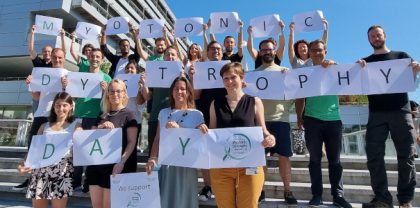
Today, September 15, 2021, marks the first International Myotonic Dystrophies Awareness Day.
Objective: to highlight these rare diseases to improve diagnosis, care and support, but also to push forward research. Euro-DyMA, a federation of ten European patient associations, of which the AFM-Telethon belongs, through the Steinert interest group, and the American association Myotonic Dystrophy Foundation, are at the origin of this first day of mobilization. Their ambition is to raise awareness among the medical profession, political leaders and the general public to improve diagnosis, care and support for patients, and to accelerate the development of drugs.
What are myotonic dystrophies?
Myotonic dystrophies – myotonic dystrophy type 1 (or DM1 or Steinert’s disease) and myotonic dystrophy type 2 (DM2) -, are rare and progressive genetic diseases. They are caused by abnormal repeats of small DNA sequences that disrupt the expression of many proteins with cascading effects on several organs. DM1 is one of the most common neuromuscular diseases in adults. It is estimated that one in 8,000 people is affected, which, for the French population, would correspond to 5,000 to 8,000 sick people living in France. DM1 and DM2 are known to be complex, but research for treatments is accelerating.
The REDs team of the Myology Ce ntre for Research of the Institute of Myology was created in 2019 following the merger of the teams of Geneviève Gourdon and Denis Furling. It also includes the group of Guillaume Bassez who coordinates the national myotonic dystrophy registry DM-Scope and that of Arnaud Ferry who is interested in muscle physiology.
The objective of this team is to create synergies in order to accelerate translational research for this neuromuscular disease and to bring out therapeutic alternatives for patients. Thus, the team’s skills aim to carry out integrated research around DM1, ranging from mutation to the understanding of physiopathological mechanisms using cell and animal models, to the development and evaluation of innovative therapeutic approaches and finally , the establishment of pre-clinical and clinical trials for this neuromuscular disease.
Further details on REDs team
Clinical trials on DM conducted at the Institute of Myology
